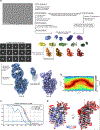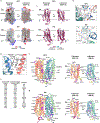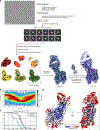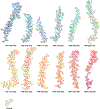Structural and molecular basis of choline uptake into the brain by FLVCR2
- PMID: 38693257
- PMCID: PMC11168207
- DOI: 10.1038/s41586-024-07326-y
Structural and molecular basis of choline uptake into the brain by FLVCR2
Abstract
Choline is an essential nutrient that the human body needs in vast quantities for cell membrane synthesis, epigenetic modification and neurotransmission. The brain has a particularly high demand for choline, but how it enters the brain remains unknown1-3. The major facilitator superfamily transporter FLVCR1 (also known as MFSD7B or SLC49A1) was recently determined to be a choline transporter but is not highly expressed at the blood-brain barrier, whereas the related protein FLVCR2 (also known as MFSD7C or SLC49A2) is expressed in endothelial cells at the blood-brain barrier4-7. Previous studies have shown that mutations in human Flvcr2 cause cerebral vascular abnormalities, hydrocephalus and embryonic lethality, but the physiological role of FLVCR2 is unknown4,5. Here we demonstrate both in vivo and in vitro that FLVCR2 is a BBB choline transporter and is responsible for the majority of choline uptake into the brain. We also determine the structures of choline-bound FLVCR2 in both inward-facing and outward-facing states using cryo-electron microscopy. These results reveal how the brain obtains choline and provide molecular-level insights into how FLVCR2 binds choline in an aromatic cage and mediates its uptake. Our work could provide a novel framework for the targeted delivery of therapeutic agents into the brain.
© 2024. The Author(s), under exclusive licence to Springer Nature Limited.
Conflict of interest statement
Competing interests
The authors declare no competing interests.
Figures













Update of
-
Structural and molecular basis of choline uptake into the brain by FLVCR2.bioRxiv [Preprint]. 2023 Oct 5:2023.10.05.561059. doi: 10.1101/2023.10.05.561059. bioRxiv. 2023. Update in: Nature. 2024 May;629(8012):704-709. doi: 10.1038/s41586-024-07326-y. PMID: 37873173 Free PMC article. Updated. Preprint.
References
-
- Institute of Medicine (US) Standing Committee on the Scientific Evaluation of Dietary Reference Intakes and its Panel on Folate, Other B Vitamins, and Choline. Dietary Reference Intakes for Thiamin, Riboflavin, Niacin, Vitamin B6, Folate, Vitamin B12, Pantothenic Acid, Biotin, and Choline. (National Academies Press (US), Washington (DC), 1998). - PubMed
-
- Hupe M et al. Gene expression profiles of brain endothelial cells during embryonic development at bulk and single-cell levels. Science Signaling 10, eaag2476 (2017). - PubMed
Additional References
-
- Kawate T & Gouaux E Fluorescence-detection size-exclusion chromatography for precrystallization screening of integral membrane proteins. Structure 14, 673–81 (2006). - PubMed
MeSH terms
Substances
Grants and funding
LinkOut - more resources
Full Text Sources
Molecular Biology Databases

